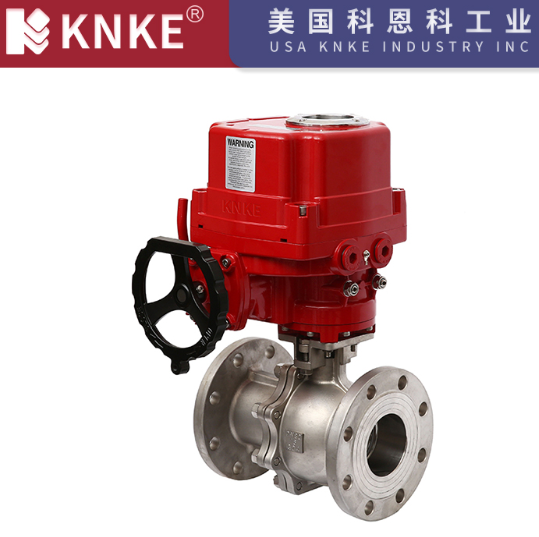Common Faults and Causes of Electric Ball Valves
Electric ball valves are widely used in industrial automation control systems due to their advantages such as easy operation, good sealing performance, and high regulation accuracy. However, various faults may occur during use, affecting their normal operation. This article analyzes the common faults and causes of electric ball valves to help users better maintain and use these devices.

1. Electric Ball Valve Fails to Operate: Symptoms and Causes
- No Signal, No Air Source
- Air source not turned on: First, check whether the air source is turned on. If not, the electric ball valve will not function.
- Moisture in the air source causes freezing: In winter, moisture in the air source may freeze, leading to blocked airways or clogged filters and pressure regulators.
- Compressor failure: A faulty compressor can lead to insufficient air supply, preventing the electric ball valve from functioning properly.
- Leaks in the main air pipe: Leaks in the main air pipe can cause insufficient air pressure, affecting the valve’s operation.
- Air Source Present but No Signal
- Regulator failure: A failure in the regulator can prevent the correct transmission of signals, affecting the operation of the electric ball valve.
- Signal line leaks: Leaks in the signal line can cause instability in signal transmission, preventing the valve from operating normally.
- Positioner bellows leakage: Leakage in the positioner bellows can interfere with signal transmission, causing the valve to malfunction.
- Damaged large diaphragm: A damaged diaphragm can disrupt signal transmission, resulting in incorrect valve actions.
- Positioner Has No Air Source
- Clogged filter: A clogged filter can block the air supply to the positioner, causing it to malfunction.
- Pressure regulator failure: A faulty pressure regulator can lead to unstable air pressure, affecting the positioner’s performance.
- Leaks or blockages in the pipeline: Leaks or blockages in the air supply pipe can prevent the positioner from receiving sufficient air, leading to failure.
- Signal Present, But No Action
- Valve stem detachment: A detached or damaged valve stem will prevent the electric ball valve from opening or closing properly.
- Valve stem stuck in the seat: The valve stem may become stuck in the seat or become jammed, preventing valve movement.
- Bent or broken valve stem: A bent or broken valve stem will hinder the valve’s ability to operate.
- Frozen or clogged valve seat: A frozen valve seat or one clogged with dirt will prevent proper operation.
- Rust on actuator springs: Rust on actuator springs, especially after prolonged periods of non-use, can cause sluggish operation or failure.
2. Electric Ball Valve’s Unstable Operation: Symptoms and Causes
- Unstable Air Source Pressure
- Compressor capacity too small: If the compressor is too small to supply adequate air pressure, the valve will operate erratically.
- Pressure regulator failure: A malfunctioning pressure regulator can cause fluctuations in air pressure, affecting the valve’s stability.
- Unstable Signal Pressure
- Improper control system time constant: If the time constant (t = rc) in the control system is not set correctly, it can lead to unstable signal output.
- Unstable regulator output: If the output from the regulator is unstable, it will affect the performance of the valve.
- Stable Air and Signal Pressures, but Valve Operation Remains Unstable
- Positioner amplifier wear: Dirt accumulation or wear in the positioner amplifier can lead to inadequate sealing of the ball valve, causing oscillation, especially when the gas consumption increases.
- Positioner nozzle deflector misalignment: If the nozzle deflector in the positioner is not parallel, it may not effectively cover the nozzle, leading to instability in valve operation.
- Leaks in output tubing: Leaks in the output tubing can result in unstable signal output, which affects valve movement.
- Insufficient actuator rigidity: Low rigidity of the actuator may result in unstable valve motion during operation.
- Excessive friction in valve stem movement: High friction in the valve stem, caused by blockages or other issues in the contact points, can result in unstable motion.
3. Electric Ball Valve Vibration: Symptoms and Causes
- Vibration at Any Opening Position
- Unstable support: An unstable support structure can cause the valve to vibrate during operation.
- Nearby vibration sources: Nearby machines or vibration sources can induce vibrations in the valve.
- Severe wear of valve plug and bushings: Significant wear of the valve plug and bushings can cause poor sealing, leading to vibrations.
- Vibration Near Closed Position
- Oversized valve: A larger valve used at a small opening is more prone to vibrations.
- Opposite flow direction at the seat: For single-seat valves, if the flow direction of the medium is opposite to the closing direction, vibrations may occur.
4. Electric Ball Valve Slow Operation: Symptoms and Causes
- Sticking in One Direction of the Stem
- Damaged and leaking diaphragm in the actuator: A damaged diaphragm will prevent proper operation of the actuator, causing slow valve movement.
- Leaking “O” seal: A leaking O-ring seal will result in insufficient sealing and slow movement of the valve.
- Stem Sticking During Reciprocating Motion
- If the valve stem sticks during reciprocating motion, it may be caused by wear, lack of lubrication, or the presence of dirt, which will slow down the valve’s action.
Electric ball valves may experience various faults during use. Understanding these common faults and their causes is crucial for timely diagnosis and maintenance. By regularly checking the air source, signal transmission, valve structure, and actuator conditions, users can detect and resolve issues early, thus extending the life of the electric ball valve and ensuring its stable performance.

Your writing doesn’t just explain things; it transforms the way we see and understand the world around us.